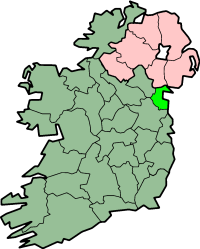County Louth
| County Louth Contae Lú |
||
| Location | ||
|
||
| Statistics | ||
| Province: | Leinster | |
| County seat: | Dundalk | |
| Code: | LH | |
| Area: | 820 km² | |
|
Population (2006) |
110,894[1] | |
| Website: www.louthcoco.ie | ||

County Louth (Irish: Contae Lú)[2][3] is a county on the east coast of Ireland, on the border with Northern Ireland.
The county town is Dundalk, which is also the largest town in Louth. The majority of the county's population live in either Dundalk or Drogheda. The 2006 Census[1] confirmed Dundalk and Drogheda as not only the largest towns in the county, but also the second and third largest towns in Ireland.
Drogheda has a population marginally larger than that of Dundalk. This however, includes areas and suburbs of Drogheda which lie in County Meath.[1]
County Louth is affectionately called "the Wee County" being the smallest county[4] in Ireland having a total area of only 821sq kilometres (317sq miles).[5]
Contents |
Origin of name
The original Irish name of the county Lughbhaidh comes from the place of worship of the Celtic god Lugh whose festival was celebrated at Lúnasa.
The names for both county and village are now spelled as An Lú. This is merely a modern standardised rendering of the older Lughbhaidh. The name has nothing to do with the comparative/superlative form lú meaning smaller or smallest of the adjective beag.
History
This is a county steeped in myth, legend and history, going back to the pre-historical days of the Táin Bó Cúailnge (Cooley Cattle Raid, see Cúchulainn). Later it saw the influence of the Vikings as seen in the name of Carlingford Lough.
There are a number of historic sites in the county, including religious sites at Monasterboice and Mellifont Abbey
In the early fourteenth century the Scottish army of Edward Bruce (brother of Robert of Bannockburn fame) was defeated in the battle of Faughart near Dundalk, Edward losing not only his claim to the High Kingship Of Ireland, but also his life. The sixteenth and seventeenth centuries featured many skirmishes and battles involving Irish and English forces. Oliver Cromwell attacked Drogheda in 1649 slaughtering the Royalist garrison (Siege of Drogheda).
Towards the end of the same century the armies of the warring Kings, James and William, faced off in North Louth during the build-up to the Battle of the Boyne - the battle takes its name from the river Boyne which reaches the sea at Drogheda.
In 1798 the leaders of the United Irishmen included Bartholomew Teeling, John Byrne and Patrick Byrne, all from Castletown; Anthony McCann from Corderry; Nicholas and Thomas Markey from Barmeath , Arthur McKeown, John Warren and James McAllister from Cambricville. They were betrayed by informers, notably a Dr. Conlan, who came from Dundalk, and an agent provocateur called Sam Turner, from Newry. Several of the leaders were hanged.
In 1816 the Wildgoose Lodge Murders took place in the west of the county.
The priest and scientist Nicholas Joseph Callan (1799–1864), from Darver, was a famous son of the county.
Notable settlements in County Louth
Towns
Villages
|
|
References
- ↑ 1.0 1.1 1.2 Central Statistics Office Census 2006 Reports. Central Statistics Office Ireland (April 2007).
- ↑ Louth - Britannica Online Encyclopedia
- ↑ Location Result
- ↑ North West Passage : : Brochures : Ireland Travel Tourism Tour Irlande Irlanda Irland Donegal Dublin Dungannon Armagh Omagh Strabane Louth Meath Monaghan
- ↑ Louth Ireland / Ireland Louth / County louth ireland / Hotel Louth, Restaurant Louth, Hotels Ireland, Travel Guide County Louth Ireland, Louth Attractions
See also
- List of abbeys and priories in the Republic of Ireland (County Louth)
External links
- Omeath Online - Official Site of Omeath, Co. Louth
- Carlingford Online - Carlingford Local and Tourist Site
- Dunleer Parish
- Louth Local Authorities
- Drogheda Tourism - Official Site of the Drogheda Tourist Office
|
||||||||||||||||||||

